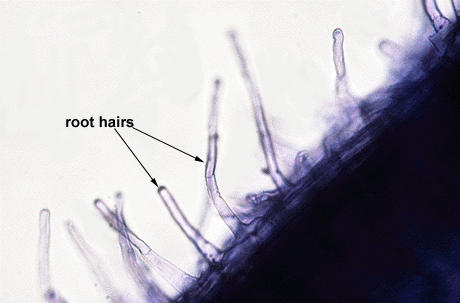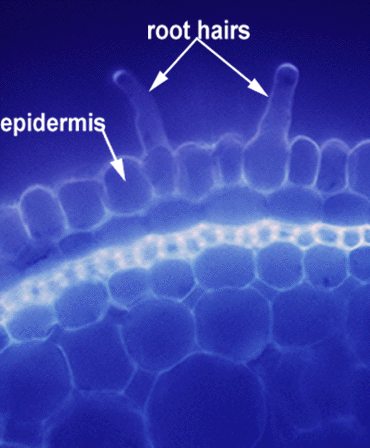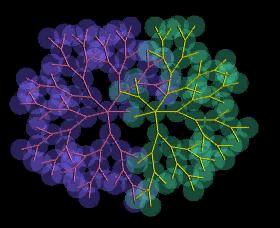|
|
The epidermis develops from the outer layer of the apical meristem. The origin of the rhizodermis is much less evident. Depending on the species, it may during evolution either have derived from the root cap or the primary bark.
The root hairs that absorb water and nutriments are an important feature of the rhizodermis. With some species of the Leguminosae family, they participate in addition in the recognition and uptake of nitrogen-fixing bacteria (belonging to the genera Rhizobium). They originate in a zone with high cell division activity. A root hair develops usually from a small extrusion (a papilla) at the apical end of a cell. In many plant species, all cell types of the rhizodermis are able to develop root hairs , while some species have specialized cells (trichoblasts) for this purpose. They are arranged at a regular pattern on the surface of the rhizodermis. The origin and the growth (elongation) of hairs in the different root parts occurs synchronized . The oldest hairs are the longest, while those nearest the root tip are shortest.


Picture to the left: This is a close-up picture of root hairs of rice. There are many root hairs in rice roots that are tubular extensions of the epidermis. Root hairs increase the absorbing surface of the root. This is important in the transpiration and the growth of the plant.Picture to the right: This is a cross section of an older rice root that is stained with flourestic berberine and with aniline blue counter stain. Berberine stains suberin and lignin, thereby showing the angular and thick cell walls of the matured cortical fibers (glowing layer at the center)
Root hairs can become as long as 80-150 Ám and as wide as 5-17 Ám in girth. They are highly vacuolate when fully differentiated. Only rarely do they consist of many cells (adventive roots of Kalanchoe). Root hairs are short-lived (a few days) and are continually replaced by new ones. The formation of root hairs helps to increase the size of the absorbing root surface drastically.
H. J. DITTMER (Department of Botany, University of Iowa) calculated the root surface of a rye plant (Secale cereale) in 1937. He counted 13 800 000 roots (including all side roots and branchings) with a total surface of 235 km2. The roots have 14 milliard living root hairs with a surface totalling 400 km2. The surface of roots and root hairs thus sums up to 635 km2. All roots of this one plant were contained in 1/22 m3. The plant surface above ground covers 1/30th of the root surface. Even if the cell walls of the mesophyll that border on the intercellular space are taken into account, the absorbing surface of the root is still 22 times as big as the transpiring surfaces of the shoot. This may look uneven, since it enables the plant to a water uptake much larger than its water transpiration. But the calculation includes many elements of uncertainty. It assumes, for example, that all root hairs are equally active. It would therefore certainly be desirable to redo such a calculation with data from another plant of the same or another species to be able to estimate the error rate and to find out whether the calculation can be generalized.
Root hairs are always in close contact with soil particles. They are often grown together and it is thus impossible to isolate a root that has been grown in the soil without impairing it. As a rule, root hairs produce carbohydrate-containing mucigel. It generates a rhizosphere, where nutriments can be processed before uptake by the plant.
Another specialized cell in the root is the endodermal cell. The endodermis forms a cylinder around the vascular cylinder in the roots. The endodermal cells have a suberin layer called the casparian strip embedded into their cell walls. This suberin can be stained using a special dye and appears when viewed under fluorescent light. The casparian strip appears as light spots in the endodermis in a longitudinal section through the root, but the suberin is laid down in a continuous layer that cannot be seen in longitudinal sections.

The Velamen
radicum is a special epidermis occurring only in aerial
roots. It is an epidermis of several cell layers that is produced by
the aerial roots of Araceae and tree-dwelling orchids. Most of its
cells are dead and store water like a sponge. The Velamen
looks silvery-white when dry, since the cells are filled with air. In
a moist state, the chloroplasts of the underlying tissue shimmer
through and the roots look green.

Root and velamen radicum of Dendrobium superbum. Light microscopic photo of the root. Velamen (V), exodermis (E), cortex ( c), endodermis (N) and central cylinder (Z).

Scanning electron microscopic photos of velamen cells. Upper picture: at low resolution. The aggregate consists of dead cells with helical strengthenings on the pit-perforated walls. Lower picture: detail of a velamen wall at high resolution. The pores and the secondary wall thickenings running crosswise at both sides of the wall can be recognized. They consist of cellulose. (W. BARTHLOTT, 1976, W. BARTHLOTT, 1984 unpublished).
|


© 1991 P. Prusinkiewicz
|